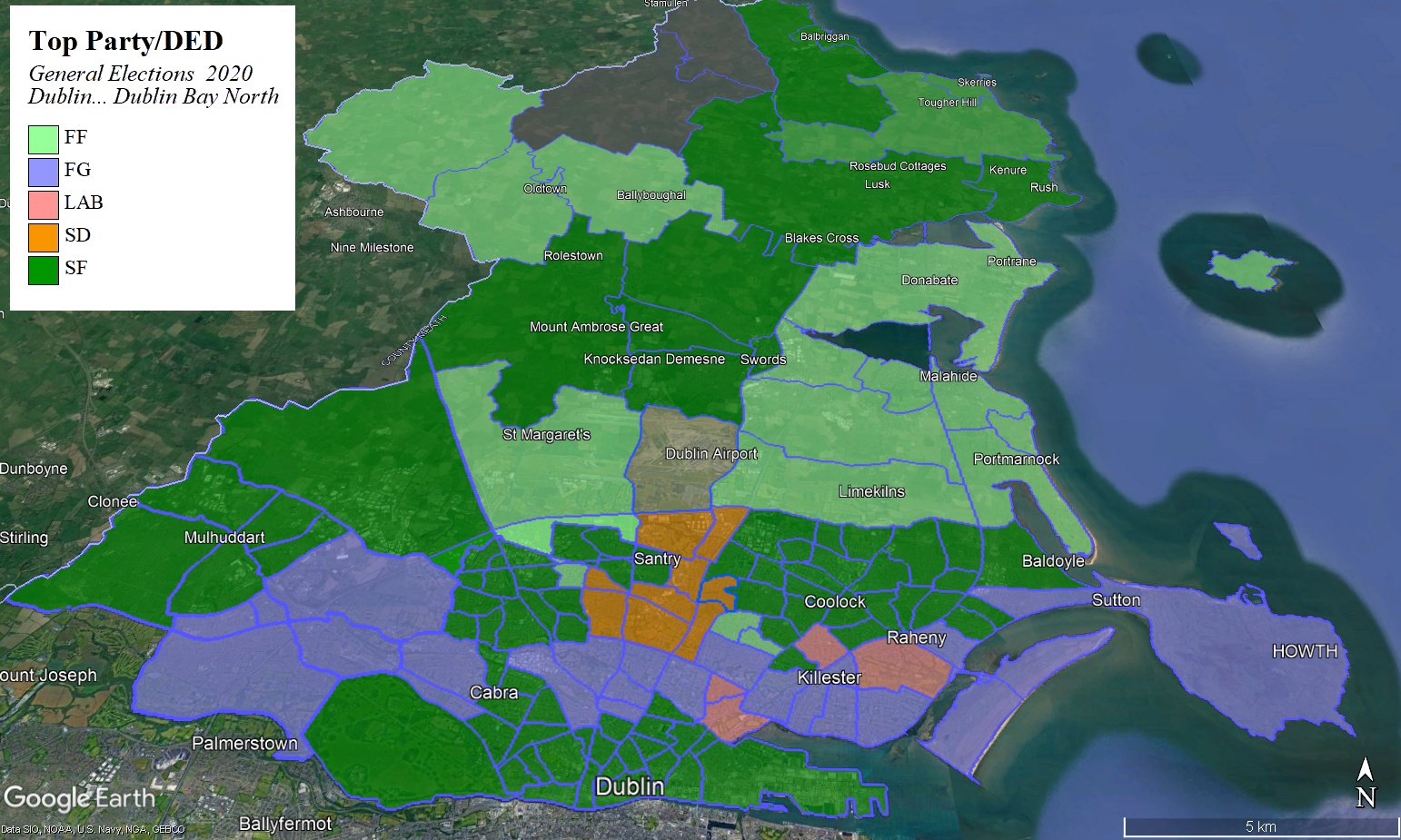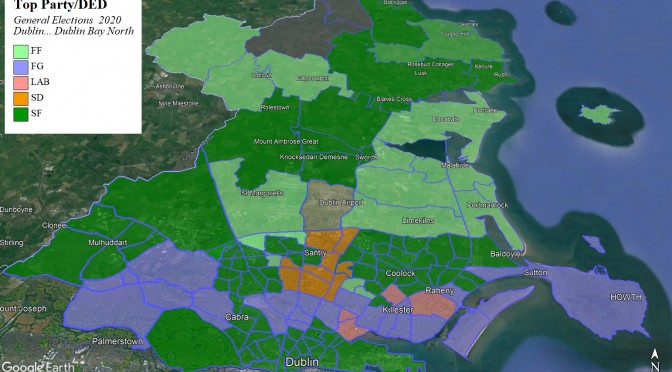In this post, I will be gradually working through the possible permutations of constituencies that the recently formed Electoral Commission might consider.
Unfortunately I’m slightly shooting blind, as the Terms of Reference merely state that “the total number of members of the Dáil, subject to Article 16.2.2° of the Constitution, shall be not less than 171 and not more than 181”. Apparently, the precise number of members the Dáil will not be set until after the Central Statistics Office releases the final population figures (sometime in the summer months) and will not be revealed until the Constituency Review report is released probably in the Autumn.
However, there seems to be a general concensus amongst people wiser than myself that the final number is likely to be somewhere between 176 and 181 in order to “future-proof” whatever scheme of constituencies is arrived at.
Accordingly, I have decided to ensure that my constituency examples below (examples – not proposals) would be within the permitted 5% variation from the National average of Population per TD for both 178 and 180 seat models.
Just to reiterate that these are examples of what the Electoral Commission MIGHT do, rather than what they WILL do – or indeed, what I think they SHOULD do.
VARIANCE
The below table shows the population limits (positive or negative) that for constituencies to be valid. Each constituency has to have a Population per TD ratio within 5% of the National Average.
TABLE 1 – PERMITTED VARIATIONS IN POPULATION FOR CONSTITUENCIES
| MAGNITUDE | 178 | 180 | ||
| Minimum | Maximum | Minimum | Maximum | |
| 3 seats | 82,034 | 90,669 | 81,123 | 89,662 |
| 4 seats | 109,379 | 120,892 | 108,164 | 119,549 |
| 5 seats | 136,724 | 151,116 | 135,204 | 149,436 |
TERMS OF REFERENCE
The Terms of Reference for the Electoral Commission are as follows.
- the total number of members of the Dáil, subject to Article 16.2.2° of the Constitution, shall be not less than 171 and not more than 181*;
- each constituency shall return 3, 4 or 5 members;
- the breaching of county boundaries shall be avoided as far as practicable.
- the reference to county boundaries shall be deemed not to include a reference to the boundary of a city or any boundary between any 2 of the counties of Dún Laoghaire-Rathdown, Fingal and South Dublin.
- each constituency shall be composed of contiguous areas;
- there shall be regard to geographic considerations including significant physical features and the extent of and the density of population in each constituency; and
- subject to the above matters, the Commission shall endeavour to maintain continuity in relation to the arrangement of constituencies.
The two important terms for me are Numbers 3 and 7, as logically interpreted it means that the integrity of county boundaries is prioritised over the continuity of current Constituency boundaries – including presumably those where county boundaries are breached.
As regards Number 2, I think it’s regrettable that larger constituencies are not permitted – besides allowing for a better share of representation, there is a reasonable case for their use in larger counties (ie Galway) or indeed in large cities (ie Dublin and Cork)
DUBLIN
I’m going to examine the Dublin constituencies in two distinct groups :
- North Dublin (Dublin Fingal, West, Mid-West, North-West, Bay North and Central)
- South Dublin (Dublin South-Central, South-West, Bay South, Rathdown and Dun Laoghaire.
NORTH DUBLIN
Firstly, the reasoning behind choosing to group these six counties.
Of the five constituencies in this area, two are in Fingal County Council – three District Electoral Divisions in Dublin West are in Dublin City. The other three in Dublin City are all north of the Liffey – three District Electoral Divisions in Dublin Bay North lie in Fingal.
A quick look at the election results in the region over the last 20 years show Fianna Fáil won a majority of the seats (11 out of 21) in 2002 – in fact they came close to winning three out of four seats in Dublin North-Central.
By contrast Sinn Féin didn’t win a seat on the Northside until the redefining election of 2011 when they took two. They came very close in 2002 in Dublin Central but lost out by less than one hundred votes. By contrast they were the largest party in 2021 with 5 of the 21 seats.
Labour were the largest party in 2011 with 8 of the 21 seats, but that was reduced to three in 2016 and just two in 2021.
TABLE 2 – POPULATION BY CONSTITUENCY
| CONSTITUENCY | POPULATION | 178 SEATS | 180 SEATS |
| Dublin Fingal | 170,690 | 5.93 | 6.00 |
| Dublin West | 134,331 | 4.67 | 4.72 |
| Dublin North-West | 90,219 | 3.13 | 3.17 |
| Dublin Bay North | 165,905 | 5.42 | 5.48 |
| Dublin Central | 123,165 | 4.28 | 4.33 |
As can be seen, Fingal now clearly has enough population for two three seat constituencies; Dublin North-West on the other hand has clearly experienced much more modest population growth and could remain a three-seater as is in a 178 seat Dail. Dublin West,
Dublin Central, Dublin West and Dublin Bay North are all without the permitted limits of variation. Dublin West could actually become a five seater with a relatively small transfer of about five thousand population – but where the required population would come from is quite problematic.
To the north, Fingal does not need to cede any population to become two three-seaters. To the south lies Lucan and a transfer of population would require splitting an electoral division and moving several thousand electors into a constituency which they don’t have strong linkages or affinity. To the east a transfer would probably involve a transfer of population from West Cabra bordering the part of Dublin West (Ashtown and much of the area of the Phoenix Park).
The more ideal solution might be to move excess population from Dublin West and Dublin Bay North into Dublin Central to make it a five seater. To the west, this would involve the return of Ashtown and the Phoenix Park into Dublin Central and eliminating the breach of the city border – to the north-east the transfer of three DEDs from Dublin Bay North would also ensure that constituency is within required representation ratio variation limits.
Two other small transfers of population would be required – the DED of Beaumont A from Dublin North-West into Dublin Bay North, and the DED of Lucan North into the constituency of Dublin Mid-West. The transfer of Beaumont A would ensure all Beaumont DEDs would be reunited in the one constituency while Lucan North is a largely rural area just north of the suburb of the same name.
DUBLIN BAY NORTH (5 seats)
The Constituency of Dublin Bay North would be broadly the same as it is now with three DEDs (covering Fairview, Marino and parts of West Clontarf) moving into Dublin Central and a small part of Beaumont moving back into the constituency.
TABLE 3 -DUBLIN BAY NORTH CONSTITUENCY DEDS
| Constituency | DISTRICT ELECTORAL DIVISIONS | POPULATION |
| Dublin BN | ALL bar Clontarf West C, D and E | 146,339 |
| Dublin NW | Beaumont A | 2,664 |
Dublin Bay North is the successor constituency to Dublin North East and Dublin North-Central, the two being abolished after 2011. Dublin North-East first appeared in 1937, after the breakup of the 8 seat Dublin City North constituency, and seems to have largely covered the area of the present day Dublin Bay North – albeit that many urban areas today away from the coast were probably still largely rural.
A constituency called Dublin North-Central appeared in 1948, but was actually centered around Glasnevin, stretching down to the Quays.
Famous names elected to Dublin North-East pre-1977 include Alfie Byrne (IND), Oscar Traynor (FF), Richard Mulcahy (FG), James Larkin (IND/LAB), Peadar Cowan (CNP/IND), Charles Haughey (FF) and Conor Cruise O’Brien (LAB).
Larkin beat Mulcahy in 1937 with heavy Fianna Fáil transfers. Cowan is the grandfather of actor of Rory Cowan and had probably the most eclectic political career of any elected politician in the last 100 years.
The modern Dublin North-East and North-Central came into existence for the 1981 election. Generally speaking, Dublin North-East had a slightly more working-class profile and its core areas were Darndale, Donaghmede, Raheny, Baldoyle, Sutton and Howth. Dublin North-Central was centered on Clontarf, Artane, Coolock and Killester – occasionally taking in parts of Drumcondra and the North Inner city in boundary reviews.
In 1981 in Dublin North-East two candidates – Michael Woods (Fianna Fáil) and Michael J Cosgrave (Fine Gael) – took over half the vote in a field of fourteen. This imbalance allowed Sean Dublin Bay Rockall Loftus to take a seat despite polling less than two and a half thousand first preferences.
Similarly in Dublin North-Central in 1981, Charles Haughey took 44% of the vote; together the top three of the thirteen candidates took two-thirds of the vote. Noel Browne won a seat for Socialist Labour in his swansong election. Fianna Fáil came close to winning three seats out of four in 1987 and they actually did it in 1989.
1987 saw a very unusual situation in Dublin North-East where the Worker’s Party won a seat due to the fiscally conservative Progressive Democrats transferring to them rather than Charlie Haughey’s son Sean on the Fianna Fáil ticket. They clearly preferred a Commie to a Haughey.
In 1992, Derek McDowell topped the poll for Labour with 10,609 votes – this collapsed to just 2,848 in 1997 but he managed to hold the last seat from Sean Dublin Bay Loftus by around 300 votes. He was narrowly beaten by Finian McGrath of the Independent Health Alliance in 2002 despite his vote improving; his vote ensured that McGrath took the last seat at the expense of Fianna Fáil.
One of the interesting side-stories in Dublin North-East was the tussle for supremacy within Labour between Sean Kenny and Tommy Broughan. I will look at in much more detail in Constituency Histories.
Finally in Dublin Bay North in 2016 Aodhain O’Riordain who was in third position on the penultimate count and looking set for a seat. However, the elimination of Anti-Austerity Alliance/People Before Profit’s John Lyons and his 8.476 votes allowed Tommy Broughan (Independents For Change), Denise Mitchell (Sinn Féin) and Finian McGrath (Independent) leap-frog over O’Riordain to take the last three seats. I’m not sure if O’Riordain believes in God or not, but if he does, he was surely forsaken by him (or her) on the final count.
MAP 1 – PROPOSED DUBLIN BAY NORTH CONSTITUENCY
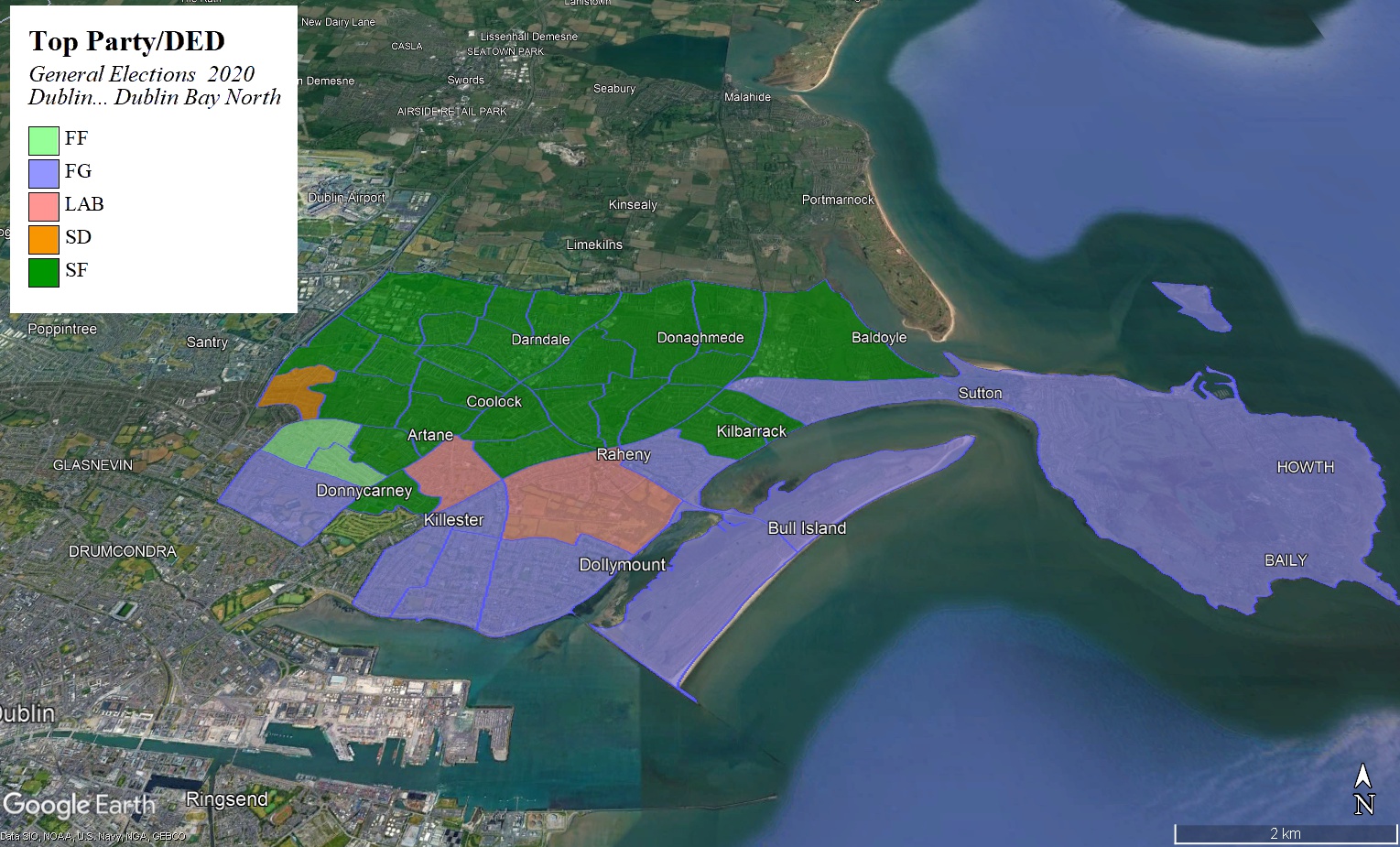
Generally speaking Sinn Féin dominate in the working-class areas across the north of the constituency, while Fine Gael tend to be ahead in the more middle-class areas in the south and east.
TABLE 4 – PARTY SUPPORT BY LEA
| SF | FG | FF | SD | LAB | OTH | IND | % | |
| Clontarf | 17% | 23% | 18% | 8% | 18% | 13% | 4% | 32% |
| Donaghmede | 38% | 16% | 12% | 7% | 10% | 11% | 6% | 30% |
| Art.-W’hall (pt.) | 52% | 10% | 13% | 5% | 5% | 7% | 9% | 23% |
| H.-M’hide (pt.) | 10% | 31% | 13% | 19% | 9% | 14% | 4% | 13% |
| A.-W (DNW pt.) | 21% | 20% | 14% | 29% | 6% | 8% | 1% | 2% |
| TOTAL | 30% | 19% | 14% | 9% | 11% | 10% | 6% |
Dublin Bay North is clearly a constituency of contrasts with Sinn Féin out-polling Fine Gael 5 to 1 in Working-class Darndale, Coolock and Kilmore (reaching 73% in parts of Darndale) while Fine Gael somewhat returns the compliment in more affluent areas.
It is unlikely these changes themselves would make any significant difference to the result of 2020 count here.
DUBLIN CENTRAL (5 seats)
The constituency of Dublin Central would consist of the DEDs in the constituency in 2020 plus the Ashtown/Navan Road area (which was previously in the constituency before being moved into Dublin West), and Fairview, Marino and parts of west Clontarf from Dublin Bay North.
TABLE 5 – DUBLIN CENTRAL CONSTITUENCY DEDS
| CONSTITUENCY | DISTRICT ELECTORAL DIVISIONS | POPULATION |
| Dublin Central | ALL | 123.,156 |
| Dublin West | Ashtown A, Ashtown B, Phoenix Park (pt) | 14,846 |
| Dublin Bay Nth | Clontarf West C, Colotraf West D, Clontarf West E |
9,566 |
Most of the Phoenix Park DED would be included in the constituency, but there are very few voters in this area – the vast majority of voters in the Phoenix Park DED are in the portion in Dublin South-Central as the
Dublin Central as it is currently constituted was first founded in 1981. It’s core area is the North Inner City and East Cabra, with Drumcondra, West Cabra and Ashtown sometimes also in the constituency. Ballyfermot, Inchicore and Kilmainham were also in the constituency for a while.
For twenty-five years from November 1982 to 2007, the constituency was dominated by two TDs – Bertie Ahern (Fianna Fáil) and Tony Gregory (Independent). They came first and second respectively in every election in that period bar 1992 when Joe Costello came second as part of the Spring Tide of that year. A host of other well-known politicians have represented the constituency : Allice Glenn (FG), Michael O’Leary (Labour), Michael Keating (FG/PD), George Colley (FF), Joe Costello (LAB), Jim Mitchell (FG) and of course more recently Mary Lou McDonald (SF) and Paschal Donohoe (FG).
A word on Michael O’Leary – he was leader of the Labour party until suddenly in October 1982 he resigned not just from the leadership but from the party and instead joined Fine Gael. In November 1982 he was elected for Fine Gael in Dublin South-West,
MAP 2 – PROPOSED DUBLIN CENTRAL CONSTITUENCY
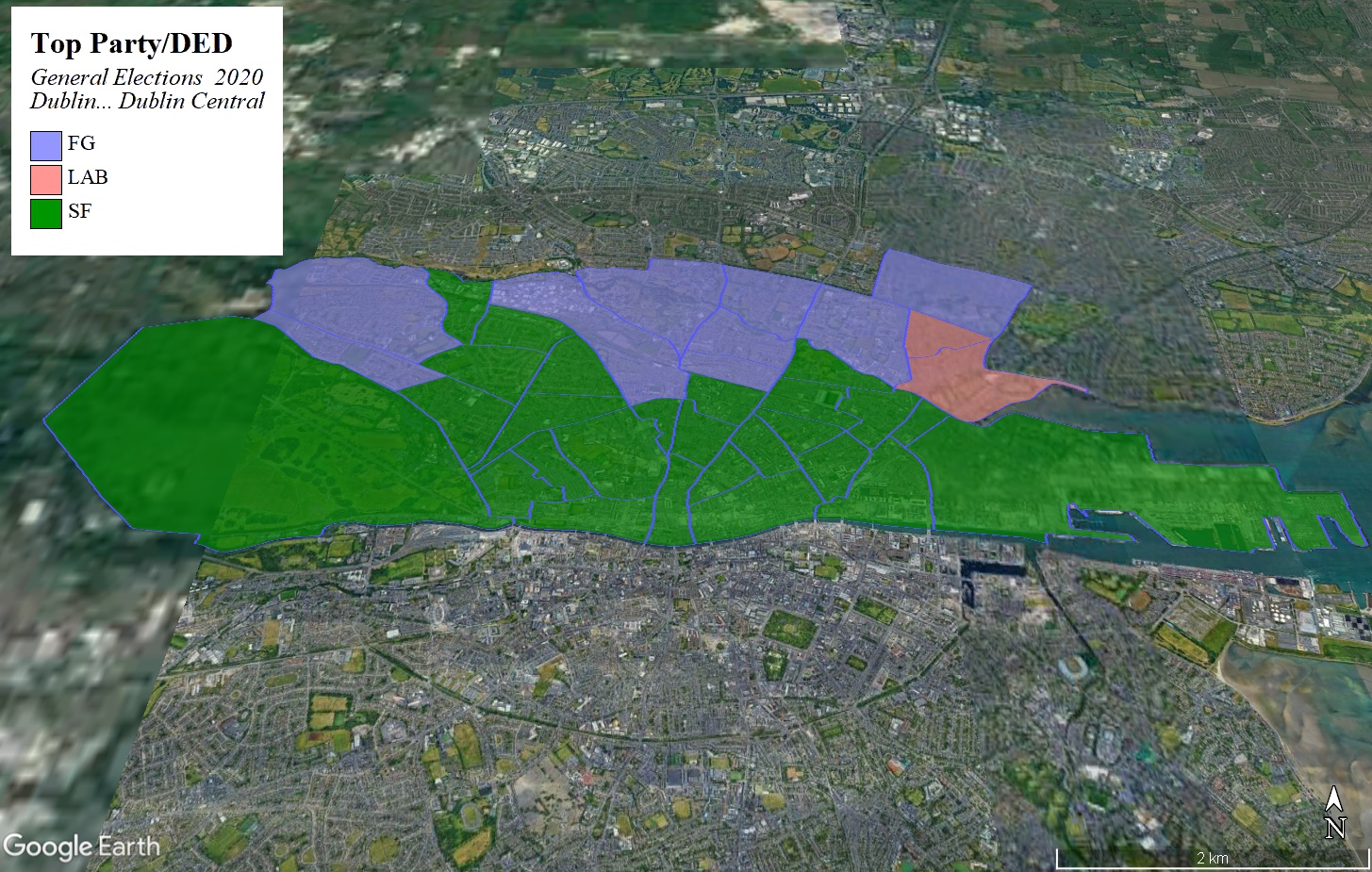
What you immediately notice is that Sinn Féin dominate in the Inner City, much of Cabra and along the quays; while Fine Gael (and Labour) are ahead in Fairview, Marino, Drumcondra and Phibsboro. This pattern probably has much to do with the various phases of development in the expansion of Dublin and its sutburbs over the last 150 years
TABLE 6 – PARTY SUPPORT BY LEA
| SF | FG | FF | GP | SD | OTH | IND | % | |
| Cab.-Gla. (pt.) | 33% | 18% | 13% | 12% | 10% | 11% | 3% | 41% |
| Nth Inner City | 41% | 11% | 5% | 11% | 9% | 13% | 10% | 32% |
| Cab.-Gla. (DW) | 23% | 24% | 17% | 11% | 3% | 19% | 3% | 13% |
| Clontarf (DBN) | 14% | 22% | 16% | 12% | 8% | 27% | 4% | 9% |
| Clontarf (pt.) | 18% | 23% | 13% | 18% | 13% | 11% | 3% | 5% |
| TOTAL | 33% | 16% | 11% | 12% | 9% | 13% | 6% |
Sinn Féin were strongest in the core areas of the constituency while Fine Gael topped the poll in the Ashtown/Navan Road area.
Sinn Féin would suffer a slight loss in their share of the vote, but would still be the most likely recipient of the extra seat.
FINGAL NORTH (3 seats)
The Constituency of Fingal North would consist of the northern half of the current Fingal constituency including the towns of Balbriggan, Donabate, Rush, Lusk and Skerries as well as rural areas further west.
TABLE 7 – FINGAL NORTH
| LEA | DEDs | POPULATION |
| Balbriggan | ALL | 40.334 |
| Lusk-Rush | ALL | 39,981 |
| Swords (pt) | Kilsallaghan | 2,427 |
The size of many of the DEDs in the Fingal area does make it difficult to come up constituency configurations for the area without splitting DEDs – hence the slightly ungainly addition of Kilsallaghan.
Dublin Fingal was first established in 2016, following on from Dublin North which was established in 1981, which itself was preceded by Dublin County North which was established in the wake of the breakup of Dublin County. These constituencies all covered roughly the same area in north Dublin.
The Burke family – Patrick and Ray – represented the constituencies mentioned above for 55 years up until 1998 – in 1977 Fianna Fáil took 55% and two out of three seats.
Other famous names associated with the constituency are Nora Owen (FG), Trevor Sargent (GP), Clare Daly (SP/IFC)
By contrast, Fine Gael took two out of three seats in Dublin North’s first three elections in 1981 and 1982, beating Fianna Fáil with help from Labour transfers. In 1987 Fianna Fáil took two out of three seats instead.
Representation broadened in the four seat Dublin North constituency; in 1989, Labour won a seat and then took a third of the vote in 1992 when the Greens took a seat (largely due to Labour failing to run a second candidate).
MAP 3 – FINGAL NORTH CONSTITUENCY
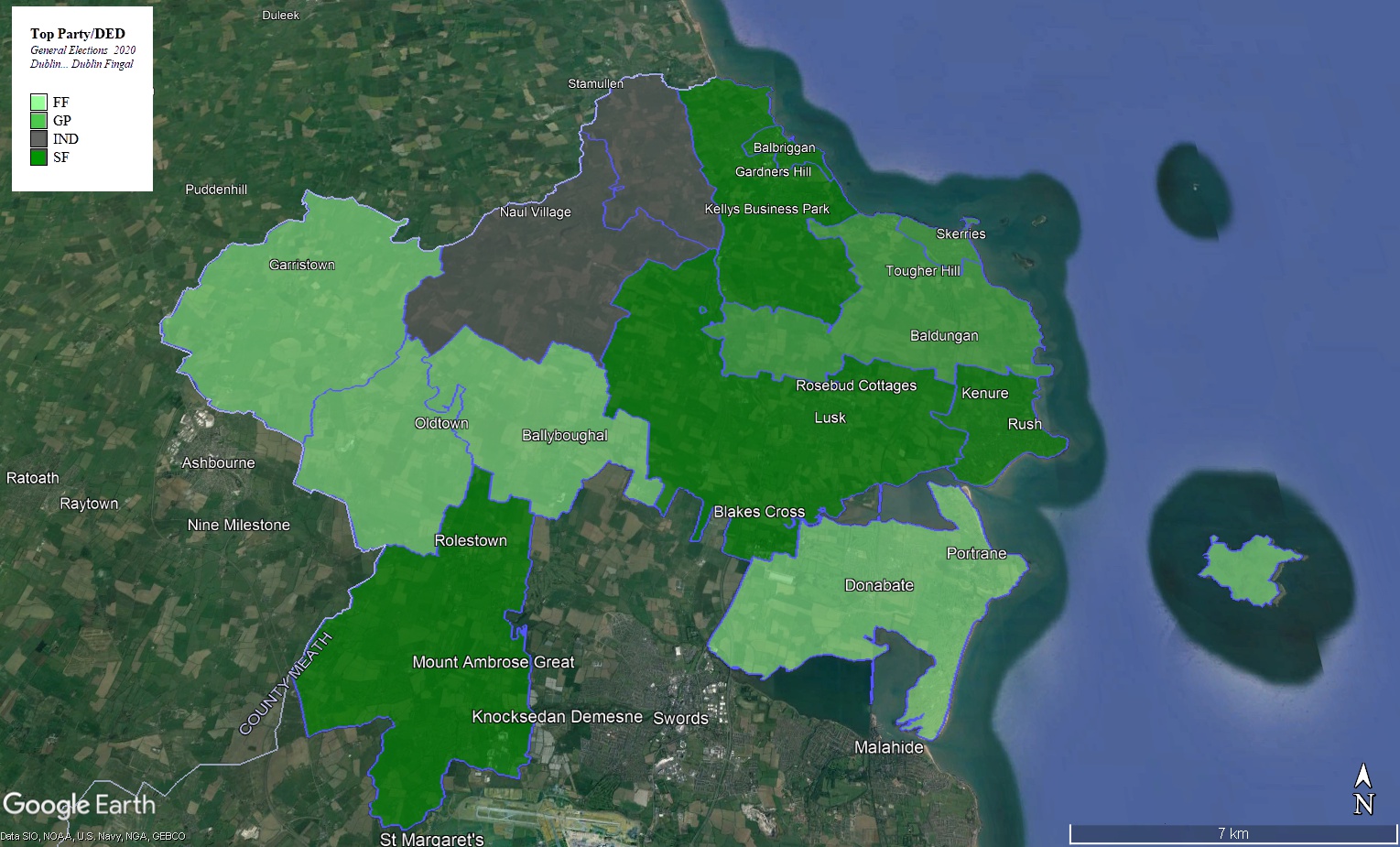
At first glance the constituency appears rather lopsided; this is because I had to transfer the rural area of Kilsallaghan to ensure that both the Fingal North and Fingal South suggestions were within the necessary deviation limits for population:representative ratio.
TABLE 8 – PARTY SUPPORT BY LEA
| SF | FG | FF | GP | LAB | OTH | IND | % | |
| Lusk-Rush | 27% | 15% | 22% | 11% | 7% | 11% | 8% | 49% |
| Balbriggan | 29% | 11% | 10% | 19% | 5% | 5% | 22% | 47% |
| Swords (pt.) | 35% | 16% | 22% | 9% | 5% | 10% | 3% | 13% |
| TOTAL | 28% | 13% | 16% | 14% | 5% | 10% | 3% | 4% |
The votes for both Fine Gael and Fianna Fáil seem to have been hit by the presence of a strong independent in Balbriggan town; the good result for the Greens here is due to their having a strong base in Skerries. The Greens’ support generally speaking has usually been stronger along the east coast.
Balbriggan Town was dominated by very strong polls for Sinn Féin and an Independent; between them they took nearly 75% of the vote.
On the above figures, Sinn Féin would take one seat…. and then it would get trickier. There probably would be one seat between Fianna Fáil and Fine Gael, and another one between the Greens and an Independent.
FINGAL SOUTH (3 seats)
The constituency of Fingal South consists of Swords (the largest town in Ireland), Malahide and Portmarnock, the increasingly urbanised Kinsaley DED and a small rural area to the west. It has a slightly more middle-class social profile than its northern neighbour, particularly in Malahide and Portmarnock.
TABLE 9 – FINGAL SOUTH DEDs
| LEA | DEDs | POPULATION |
| Malahide-P’marnock | ALL | 40,324 |
| Swords (pt.) | ALL except Kilsallaghan | 45,797 |
| B.-M’huddart (pt.) | Dubber | 1,112 |
MAP 4 – FINGAL SOUTH CONSTITUENCY
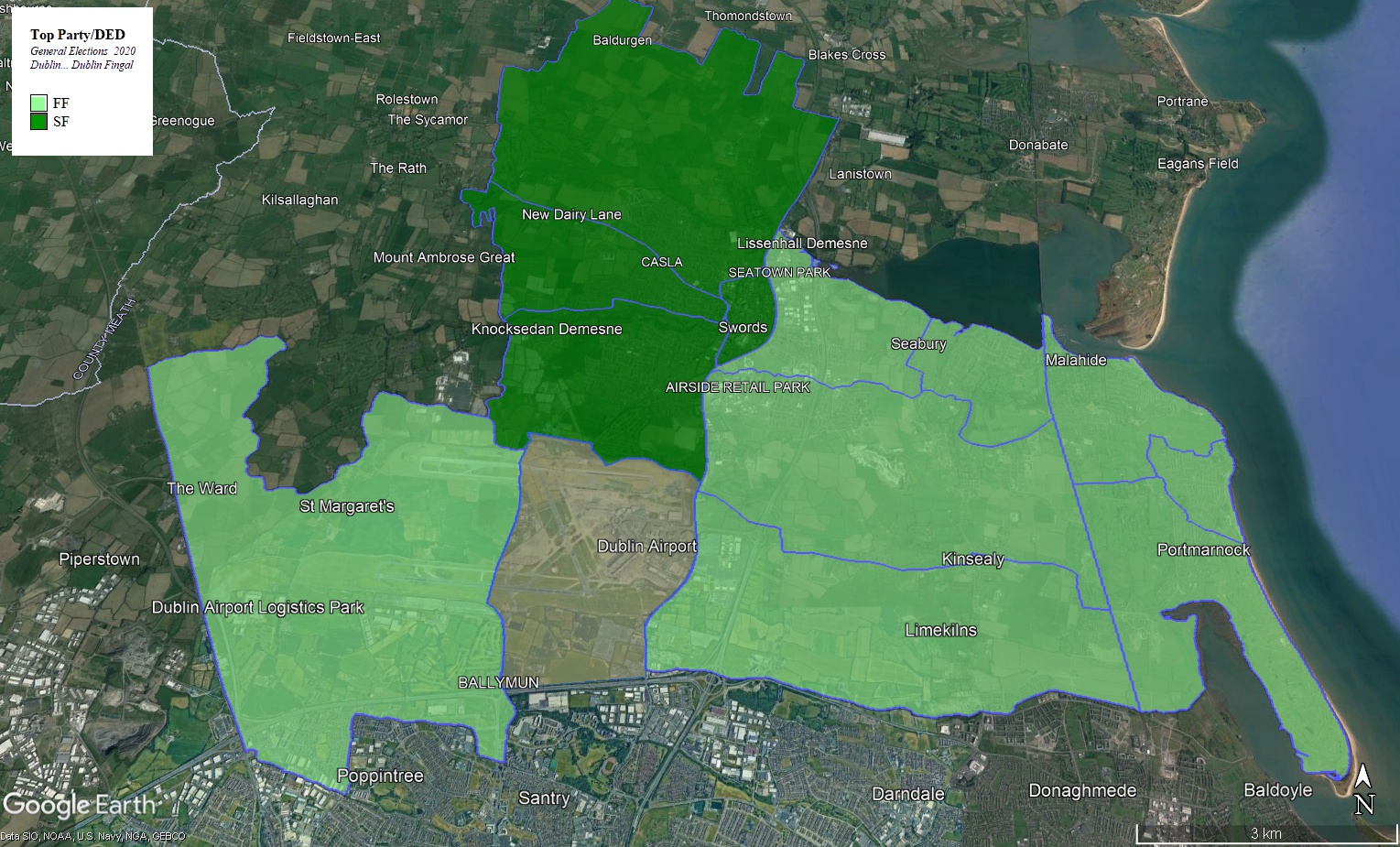
Fianna Fáil topped the poll in Malahide and Portmarnock, while Sinn Féin was ahead in Swords.
TABLE 10 – PARTY SUPPORT BY LEA
| SF | FG | FF | GP | LAB | OTH | IND | % | |
| Swords | 31% | 13% | 19% | 9% | 11% | 13% | 4% | 48% |
| M’hide-P’nock | 14% | 21% | 34% | 15% | 5% | 7% | 3% | 49% |
| B’town- M. (pt.) | 27% | 12% | 31% | 7% | 5% | 11% | 6% | 2% |
| TOTAL | 22% | 17% | 27% | 12% | 8% | 10% | 4% |
The first thing to notice is the obvious differences between the results in Swords and Malahide-Portmarnock – in the former the Government parties took 41% of the vote compared to 55% for the opposition, in the latter the Government took 70% to 26%. This is probably partly due to candidate influence, but there is definitely a demographic factor at play as well.
On the above figures, Fianna Fáil and Sinn Féin would be guaranteed a seat, and Fine Gael would probably take the last seat at the expense of the Green Party.
DUBLIN NORTH-WEST (4 seats)
The constituency of Dublin North-West remains virtually the same bar the movement of Beaumont A back into Dublin Bay North.
TABLE 11 – DUBLIN NORTH-WEST DEDs
| Constituency | DEDs | POPULATION |
| Dublin North-West | ALL except Beaumont A | 86,785 |
The only change to Dublin North-West would be the movement of a small part of Beaumont back into Dublin Bay North.
A Dublin North-West constituency has existed since 1937 – except for 1977 – but it’s only since 1981 that the constituency has consisted of the key areas of Ballymun and Finglas consistently.
In its first outing in 1981, the constituency returned two Fianna Fáil and two Fine Gael TDs – which is probably unlikely to be repeated any time soon. Left-wing parties (Labour, Socialist Labour, Sinn Féin Worker’s Party) had over a quota between them, but vote leakage (and good balancing by Fine Gael) meant that Fine Gael took the last seat from Labour by less than 500 votes. Proinnsias De Rossa took a seat for SFWP in February 1982.
In 1992, Labour topped the poll and took a seat at the expense of Fianna Fáil whose support had been weakened at the previous election in 1992. Fianna Fáil won back their seat in 1997 at the expense of Fine Gael who in turn were only 100 votes behind Proinnsias De Rossa (now of Democratic Left) – De Rossa took the hint and didn’t run again.
Sinn Féin first contested the constituency in 1987, they took 3% and similar amount in 1989 and 1992. They didn’t contest in 1997, but took 18% in 2002, and started ahead of Roisin Shortall of Labour who overtook them on later counts. However their vote slipped back to 16% in 2007 and they didn’t win a seat until 2011, when Labour took the other two seats.
MAP 5 – DUBLIN NORTH-WEST CONSTITUENCY
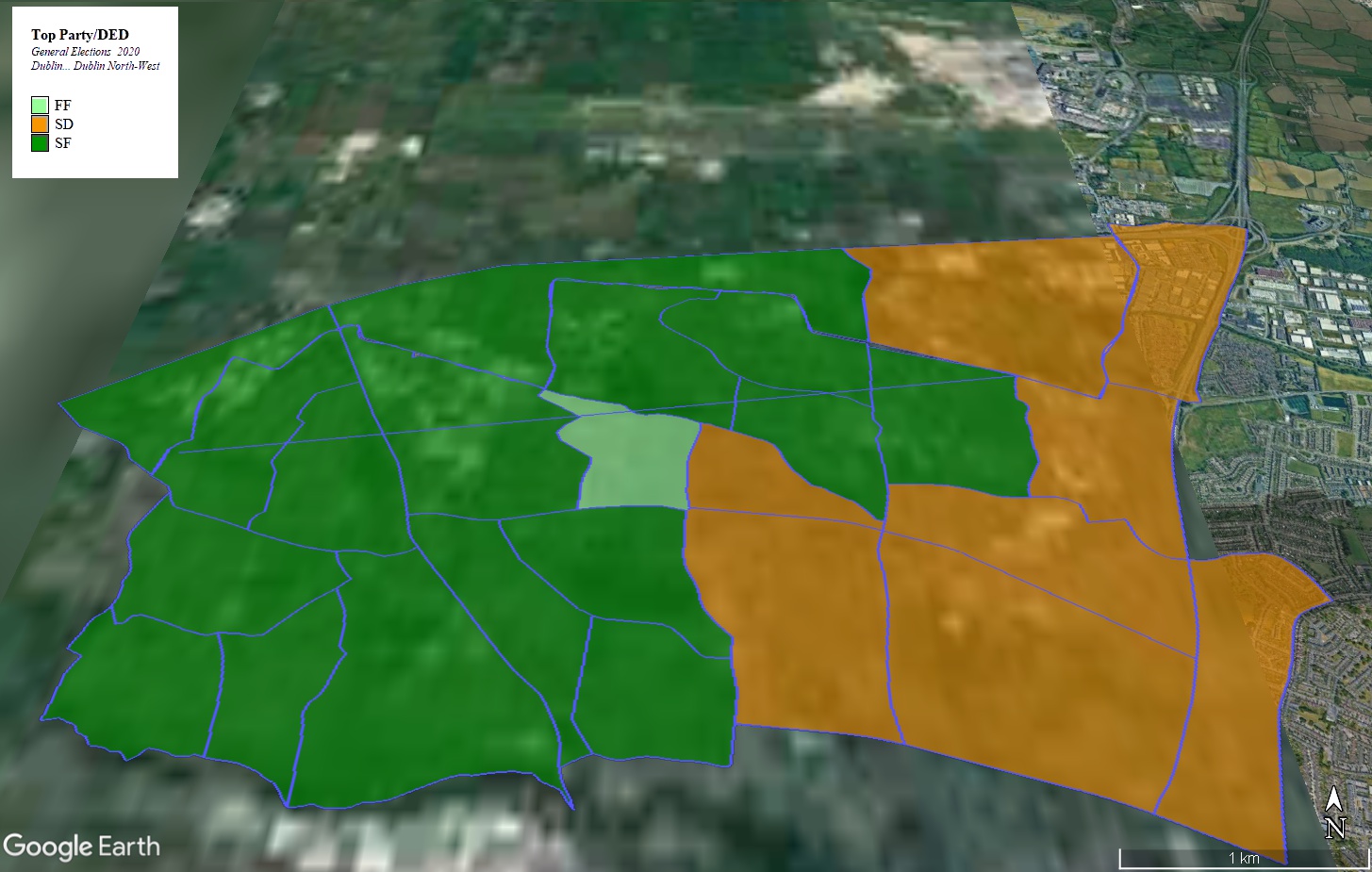
Sinn Féin topped the poll across much of Ballymun and Finglas, while the Social Democrats were ahead in the Whitehall area.
TABLE 12 – PARTY SUPPORT BY LEA
| SF | FG | FF | SD | OTH | IND | % | |
| Ballymun-Finglas | 52% | 8% | 12% | 16% | 12% | 1% | 74% |
| Artane-Whitehall (pt.) | 18% | 21% | 12% | 30% | 16% | 1% | 17% |
| B’town-M. (pt.) | 55% | 7% | 10% | 14% | 13% | 1% | 5% |
| Swords (pt.) | 26% | 20% | 8% | 29% | 7% | 3% | 3% |
| TOTAL | 45% | 10% | 12% | 19% | 13% | 1% |
Roughly 80% of the votes came from the wider Ballymun-Finglas area (The parts in Blanchardstown-Mulhuudart are mainly an extension of Finglas) and 20% from the Whitehall area (including estates in Swords area south of the M50).
The Sinn Féin was very high in Ballymun-Finglas, but it goes even higher when you take Glasnevin out of the equation – just over 70% in Ballymun proper and just under 70% in Finglas (but up to 80% in some areas).
On these figures, you would expect the same result as in 2020, given the small movement of votes.
DUBLIN WEST (4 seats)
The constituency of Dublin West would remain the same bar the transfer of Ashtown and the Phoenix Park to Dublin Central, and the transfer of Lucan North to Dublin Mid-West.
Despite being in a different council area (South Dublin, the transfer of Lucan North actually makes sense as it is a rural area dominated by a golf course, and the housing estates within are clustered on its southern boundary on the edge of Lucan town.
TABLE 13 – Dublin West DEDs
| Constituency | DEDs | POPULATION |
| Dublin West | ALL except Ashtown A, Ashtown B, Phoenix Park in Cabra-Glasnevin and Lucan North in Castleknock | 82,682 |
Dublin West would consist of the established suburbs of Castleknock, Blanchardstown, Mulhuddart, as well newer settlements in Ongar and Tyrrellstown.
Dublin West was first established in 1981 and covered much of the current constituency as well as Lucan and Palmerstown to the south. It was preceded by the three seat Dublin County West constituency in 1977 which covered much of the territory of the current Dublin West and Dublin Mid-West as well as Celbridge, Leixlip and Maynooth in Kildare – the same area would support 11 seats today.
If the idea to form such a constituency was part of the nefarious Tullymander plan, it came badly unstuck with Fianna Fáil taking nearly 60% of the first preference vote and two of the three seats.
The original five seat Dublin West contained Ballyfermot, Lucan, Palmerstown and parts of Cabra and Kilmainham as well the current constituency, and in the first two elections in 1981 and 1982, returned three Fine Gael TDs to Fianna Fáil’s two until Tomas MacGiolla of the Worker’s Party took a seat from Fine Gael in November 1982.
The decision by the Fianna Fáil government to appoint Fine Gael’s Richard Burke to the European Commission in the summer of 1982 is sometimes referred to as a failed stroke, although the actual motive may have been to avoid a seat loss rather than gain one. In any event, the trees that were planted in advance of the election doubtless went on to pastures anew soon after apparently.
Paddy Power TD – then Fianna Fáil Minister for Defence – was canvassing in that election when he was caught at a door by a woman who went in great detail about how she was disgusted with Fianna Fáil and wouldn’t vote for them again, et cetera, et cetera. Having finally been given the litany of sins he and his ilk were undoutedly guilty of, he moved to canvass the next house. The lady, espying this, shouted that no-one lives there anymore. His curt reply was “That doesn’t surprise me Madam!”.
In 1987, Fianna Fáil were in the hunt for a third seat, but Olga Bennett was beaten by Pat O’Malley (a cousin of Dessie’s) of the Progressive Democrats; in 1989, Bennett finished less than a hundred votes behind her colleague Liam Lawlor. Lawlor had another narrow escape in 1992when he beat Tomas MacGiolla for the last seat by only 50 votes.
In 1996, Brian Lenihan Jnr. narrowly won the bye-election caused by the death of his father from Independent candidate Joe Higgins who won a seat for the Socialist Party in the 1997 election. Between 1992 and 2002, the constituency included Lucan and Clondalkin – they later became the core areas of Dublin Mid-West.
2002 saw the constituency reduced to three seats, with Joan Burton of Labour beating Fine Gael for the last seat. Leo Varadkar took the seat back for Fine Gael from Joe Higgins in 2007. In 2011 Brian Lenihan jnr. won the sole seat for Fianna Fáil in Dublin.
MAP 6 – DUBLIN WEST CONSTITUENCY
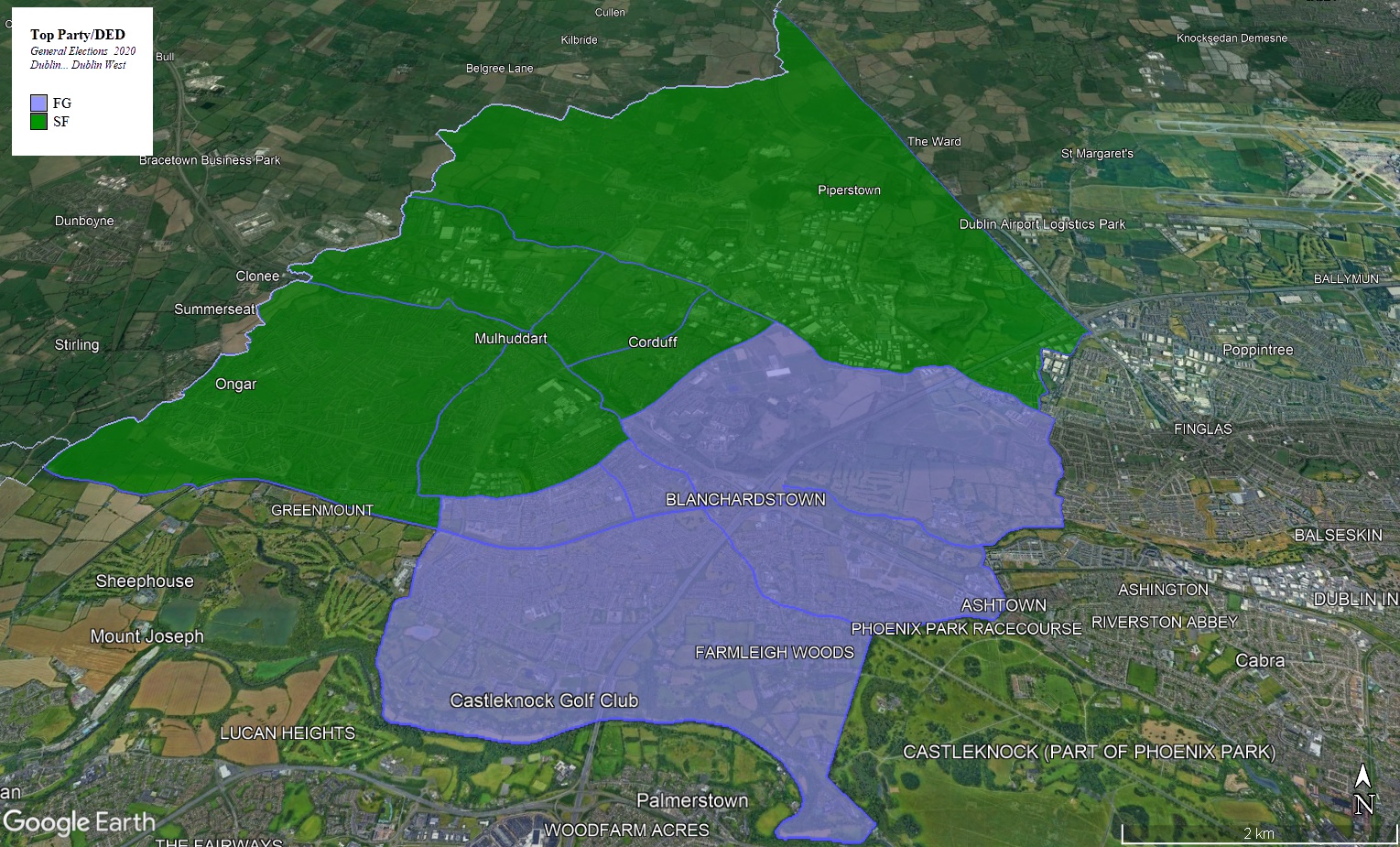
There’s something of a North-South split in Dublin West, with Fine Gael topping the poll in Castleknock and Blanchardstown, while Sinn Féin dominate in Mulhuddart and Ongar.
TABLE 14 – PARTY SUPPORT BY LEA
| SF | FG | FF | GP | LEFT | OTH | IND | % | |
| Castleknock | 15% | 33% | 18% | 17% | 7% | 10% | 1% | 47% |
| Ongar | 40% | 17% | 14% | 7% | 14% | 8% | 1% | 40% |
| B’town- M. (pt.) | 50% | 12% | 12% | 6% | 13% | 6% | 2% | 13% |
| TOTAL | 29% | 24% | 16% | 11% | 10% | 8% | 1% |
Similar to Fingal South, there are wide variations in support across the constituency. In Castleknock, the Government parties outpolled the Opposition by over 2 to 1; in Blanchardstown-Mulhuddart the Opposition parties outpolled the Government by over 2 to `1.
On the above figures, the gap between the Greens and Solidarity/People-Before-Profit on the final count would probably be closer, but the result would remain unchanged.
CONCLUSION
Below is the suggested set of six possible constituencies to replace the current five in North Dublin County and City. Fingal would be split seamlessly into Fingal North and South three seat constituencies. The other seat gain would be in Dublin Central which would take in six DEDs from Dublin West and Dublin Bay North to make a five seater. There are two other small populations from Dublin Nth-West to Dublin Bay North and Dublin West to Dublin Mid-West.
TABLE 15 – SUGGESTED CONSTITUENCIES
| CONSTITUENCY | SEATS | POPULATION | VAR178 | SF | FG | FF | OTH | IND |
| Dublin Bay North | 5 | 149,003 | +3.7% | 30% | 19% | 14% | 30% | 6% |
| Dublin Central | 5 | 147,568 | +2.5% | 33% | 16% | 11% | 34% | 6% |
| Dub Fingal North | 3 | 82,752 | -4.2% | 28% | 13% | 16% | 28% | 14% |
| Dub Fingal South | 3 | 87,223 | +1.0% | 22% | 17% | 27% | 30% | 6% |
| Dublin Nth-West | 3 | 86,785 | -0.5% | 45% | 10% | 12% | 32% | 1% |
| Dublin West | 4 | 118,891 | +3.3% | 29% | 24% | 16% | 29% | 1% |
There would be four populations transfers totalling …. 2 would be minor transfers which actually help reunite communities and another removes a breach in the city-county boundary.
Firstly, just under 15,000 population would be transferred from Dublin West into Dublin Central in the Ashtown/Navan Road area where it was previously in 2020.
Fairview and Marino and parts of West Clontarf would be transferred into Dublin from Dublin Bay North – total population transfer would be 9.566. Beaumont A (population 2,664) would be transferred into DBN from Dublin Nth-West – this would reunite all the Beaumont DEDs.
Finally Lucan North (population 1,772) would be moved into Dublin Mid-West.
Overall roughly 1 in 23 people find themselves moving constituency (excluding the split of Fingal).
MAP 8 – NORTH DUBLIN
